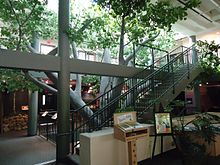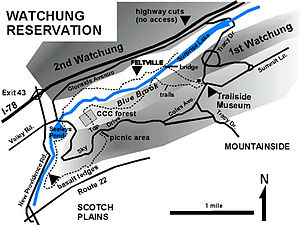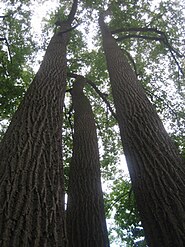|
Watchung Reservation
Watchung Reservation is the largest nature reserve in Union County, New Jersey, United States.[1] The Watchung area is located on a ridge within northern-central New Jersey, as it consists mainly of the upper valley of Blue Brook, between the ridges of the First Watchung Mountain and Second Watchung Mountains. A dam near the headwaters of the creek creates Lake Surprise. The reservation covers an area of 1,945 acres (787 ha), as it is bounded by the city of Summit, the borough of Mountainside, and the townships of Berkeley Heights, Scotch Plains, and Springfield. Geology and fossil recordThe Blue Brook has carved a valley in the Reservation between the 1st and 2nd Watchung Mountains along the strike of the less weathering-resistant red beds of the early Jurassic Feltville Formation. The Feltville Formation is a mapped bedrock unit primarily in New Jersey named for the Deserted Village of Feltville in the Reservation, which is near where its type section was described. Red sandstone and shale beds of this formation crop out along stream level and along an old, abandoned mill race that follows the north side of the stream. On the south side of the stream are exposures of a highly fractured flow of the base of the Orange Mountain Basalt. The best exposures of the red beds are along the abandoned mill race and along cut banks in the stream and its tributaries.[2] Paleontologist Paul E. Olsen uncovered ancient dinosaur fossils in the Reservation in the 1970s.[3] The Ruth Canstein Yablonsky Self-Guided Geology Trail in the Reservation allows exploration of the geological features in the Reservation.[4] HistoryThe purple-blazed Watchung Reservation History Trail is a six-mile trail through various historical points in the reserve.[5] It was designed and executed by Rob Gruytch of Roselle Park.[6] Lenape eraThe original inhabitants of the Watchungs, the Lenape, referred to the mountains as the Wach Unks, or 'high hills'.[2][7] Evidence of the Lenape presence in the Watchungs can be seen in numerous camp sites that have been uncovered, mainly along the rivers coursing through mountains and in the small caves abundant in the volcanic rock. It is thought the Lenape favored the Watchungs for their profusion of natural resources, including abundant freshwater rivers and streams, a variety of forests, and plentiful fish and game.[8] The Lenape may have also used crushed copper ore for tools and decoration.[5] The Mo-No-Pe-Nonck trail historically wound through the Reservation.[6] European settlementAn abandoned copper mine exists in the Reservation. Some believe exploration for copper in the Reservation may date back to at least the 1600s.[5] About 1736, a frontier settler named Peter Willcocks built a sawmill along the Blue Brook, clearing hundreds of acres of forest to meet the lumber demands of farmers on the frontier. Deserted villageAn entire village, Feltville, once existed in the woods in the northwestern quadrant.[9] In 1845, David Felt built a printing factory along the brook. He eventually built a whole town on the bluff above the brook to support the mill operation. Around 175 people were living in Feltville by 1850.[10] After Felt's retirement in 1860, other business ventures were tried but failed, and the town became deserted for a short time. In 1882, Warren Ackerman bought the property and converted it to a summer resort, called Glenside Park, offering golf, boating, and horseback riding. When the popularity of mountain resorts ended as the Jersey Shore grew as a vacation destination thanks to the automobile, Glenside Park closed in 1916.[11] The Murals de la SelvaIn 1916, the Deserted Village fell into decline upon the closure of Glenside Park. A local civil engineer and travel enthusiast named Edward J. Grassmann purchased a number of properties to serve as a club, which he eventually sold to the Union County Parks Commission. Grassmann was a lifelong Elizabeth resident who made his fortune in land surveying and kaolin processing; the trust that bears his name is still in existence today.[12] Grassmann decorated two of his structures at the Deserted Village to demonstrate his fondness for the Southwest and Latin America. He called one the "Mexican Cottage" and the other he christened as the "Indian Cottage."[13]
Several years after they were painted, the murals were covered by wallpaper, which is how they remained for decades until uncovered in the 1970s.[15] The location of the murals in the Deserted Village was named by Preservation New Jersey as one of the 10 Most Endangered Historic Sites in New Jersey.[16] The Union County Park System and the formation of the ReservationSoon after the Union County Park System was formed in 1921, purchasing land to create the Rahway River Parkway to the east, this area was incorporated into the Watchung Reservation. The March 23, 1927, edition of The Westfield Leader describes the creation of new bridle trails in the young park.[11] Enchanted Forest and other apocryphal talesStories of paganism and witchcraft surround what is known as the Enchanted or Magic Forest in the Reservation. The Enchanted Forest is a pine plantation of 16,000 trees placed in "endless, ruler-straight rows" by the New Deal-era Civilian Conservation Corps during the 1930s.[10] The forest contains white spruce, red pine, and Norway spruce which are not native to the area; native trees replace the pines as they die.[17] It has suffered heavily from pine beetle predation in recent years. Other tales of hauntings and witchcraft abound in the Reservation, as well as apocryphal tales of black magic and teenage devil worship. Some arose likely in relation to real-life teenage murder and suicide in the area, such as in nearby Houdaille Quarry (Jeannette DePalma).[18][19][20] According to one true-crime writer, "Throughout the 1970s and up into the 2000s, there were reports of 'devil worship' in [Watchung Reservation]. There are police reports and newspaper accounts to back that up. So it was all going on in this hot spot of weird, paranormal activity."[21] Some say 13 witches are buried beneath the stretch of road that runs from Watchung to Scotch Plains by the Reservation.[22][23] RecreationWhile there are recreation areas within the reservation, much of the 1,945 acre (7.8 km2) parcel is forested, and the reservation is managed for the preservation of its natural resources. The most popular recreational activities in the reservation are hiking and horseback riding on its many trails. Fishing, kayaking and boating is permitted on Lake Surprise, Moxon Pond, and Seeley's Pond.[24] Biking on the hilly paved road through Watchung Reservation is popular; off-road mountain biking is illegal.[25][26] Climbers within the state have been drawn to the bouldering opportunities on the cliffs along the brook and Diamond Hill Road at the Watchung's western boundary, although climbing is technically prohibited by the county. PlayAt the center is the Loop area, a large park with picnic tables and a play area called "'The Loop Playground.'"[27]   Trailside Nature & Science Center Built in 1941, the Trailside Nature & Science Center is at the southern edge, along Coles Avenue in Mountainside. It is the oldest nature center in New Jersey.[28]  Demonstration GardensThe Rutgers Master Gardeners of Union County ("RMGUC") are volunteers who provide gardening, land stewardship and horticultural therapy services in Union County. RMGUC is headquartered in the County building at 300 North Ave. East in Westfield. Their Demonstration Gardens in the Watchung Reservation next to Trailside Museum include various theme gardens, two flower-cutting gardens, the Berry Patch, herb and Harry Potter Gardens, and the Community Sharing Garden and Annex, where varieties of vegetables are cultivated for donation.[29] Watchung StablesThe county-owned Watchung Stables are located on a large cleared area in the eastern end of the park.[30] The clearing was created in the late 1950s when, against strong local opposition, the U.S. Army built the Cold War defensive Nike missile base here.[31] The preserve has 26 miles of equestrian trails.[32]  Hiking trailsSome have commented on the poor condition of the Reservation's trails. Topsoil has been worn or washed away, leaving rock below, and trails are poorly marked.[33][34][35] In October 2017, the county issued a new interactive trail map for hikers to better navigate and to report trail problems.[36] EcologyWatchung Reservation, at ecological equilibrium, hosts mostly beech-maple-pine forest.[37] Native speciesCommon native plant species include: Common native animal species include: Invasive speciesBecause of its location in one of the most densely populated regions of the United States, various alien invasive species have become established in the Reservation over the years. Common invasive plant species include: Common invasive animal species include:
Extirpated or lost species Some native species used to live in the Reservation but no longer can be found there, including:
However, a decade later, research by Zappalorti (1989) suggested that the bog turtle had been extirpated from the Reservation due to habitat degradation. Endangered blue spotted salamanderThe Army Corps of Engineers wrote in 1981:
Unique natural springs and salamander habitatIn its 1981 environmental impact report on a flood control project,[39] Army Corps of Engineers discussed the unique natural spring environment in the Reservation, which provided habitat for six species of salamander:
Environmental concernsGovernmental land takingsIn spite of heavy local public protest, higher levels of government have taken land in the reservation twice for their own purposes. The first time was in the late 1950s when the U.S. Army built a Nike missile base and operated it between 1957 and 1963 to defend the airways over New York City. Today, the site has been redeveloped for use as Watchung Stables. A more lasting effect on the reservation came in the 1980s when, following years of litigation and public activism, the New Jersey Department of Transportation won approval to build I-78 through the northern fringe of the reservation. Wildlife crossings designed to allow wildlife to travel safely between the severed parts of the Watchung Reservation were built. 2017 mountain biking controversyIn 2017, local controversy[40] erupted over efforts to introduce mountain biking in the Reservation by mountain biking enthusiasts, including Princeton-based Jersey Off Road Bicycle Association (JORBA).[41][25] The Sierra Club,[42] other environmentalists, and hikers claimed that the county had failed to behave transparently in working with a group of cyclists and bicycle store owners in pushing a plan to carve 13.5 new miles of bike-only trail in untouched forest in the Reservation.[43] They asserted that no environmental impact studies had been performed on the Reservation itself, that hiking advocates like the New York–New Jersey Trail Conference (NYNJTC) had not been consulted, that no attention had been paid to the Olmsted landscape architectural legacy of the reserve, and that the county had gone straight to hiring an engineering consultant firm, Parlin-based CME Associates,[44] to draft a master plan to insert the bike-only trails.[45][46][47] In response, one Union County bicycle store owner dismissed concerns as biased and misguided hysteria, noting the many health benefits of mountain biking.[48][49] See also
Photos
References
External linksWikimedia Commons has media related to Watchung Reservation.
|
|||||||||||||||||||









